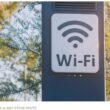SWR, impedance and line loss
Standing waves on a transmission line affects both the impedance seen at the input and the overall loss of the transmission line — the higher the SWR, the greater the effect on these parameters.
This column deals with the practical aspects of SWR, line loss and input impedance.
Forward/reflected power
In last month’s column, we discussed the use of the directional wattmeter in making measurements of forward and reflected power on the transmission line.
Figure 1 shows the setup in which the directional wattmeter is used to measure forward and reflected power. At A., the directional wattmeter is set to measure forward or incident power.
Suppose that the transmission line has a theoretical loss of 0dB. This means that all of the forward or incident power at the input of the line will reach the antenna. If the antenna is perfectly matched to the line, all of the forward power will be radiated by the antenna and no power will be reflected back down the line. If the transmitter output power is 100W, the power reaching the antenna is 100W and the reflected power is zero.
Next, suppose that the antenna is not perfectly matched to the transmission line impedance. In this case, some of the power will be reflected back down the line toward the source or input. Since the line has no loss, all of the reflected power will reach the transmitter.
Suppose that the load impedance is 150 ohms purely resistive and the transmission line is a length such that the impedance at the input of the line is 30 – j40Ω. This would cause an SWR of 3:1. Since the line is lossless, the SWR would be the same at all points on the line. An SWR of 3:1 means that the reflected power would be 25 percent of the incident or forward power.
See Figure 2. The length of the jumper cable is such that the length of the cable plus the through-line section of the wattmeter is equal to one-half wavelength at the operating frequency. When calculating this length, be sure to consider the cable’s velocity factor. If the transmitter output power was 100W into a perfectly matched load impedance, then the transmitter’s output circuit should be adjusted to provide a net (forward minus reflected) power of 100W by tuning the transmitter output for a conjugate match. The conjugate match impedance in this case would be 30 + j40Ω, since the line input impedance is 30 – j40Ω.
If the transmitter output is capable of being tuned to provide the conjugate match, the forward power should read 133.3 watts and the reflected power should read 33.3 watts. The reflected power (still 25 percent) adds to the forward power of 100W to produce the total incident or forward power of 133.3 watts. If the transmitter output can’t be adjusted to compensate for the mismatch, try changing the length of the line between the line input and transmitter output. This will change the impedance seen by the transmitter.
Several different lengths should be tried until a length is found to provide an impedance into which the transmitter can be tuned. Don’t change the length of the jumper cable between the wattmeter and the transmitter. It must remain the same so that the situation doesn’t change when the wattmeter and jumper cable are removed from the line.
If the transmitter isn’t cable of being tuned into the mismatched impedance, try using a device called a line matcher or Z-matcher between the line input and the transmitter output. See Figure 3. With the pi-network line matcher in the line and properly tuned, wattmeter No. 1 will read 100W forward power and 0W reflected power. Wattmeter No. 2 will indicate 133.3W forward power and 33.3W reflected power. The net power is 133.3W minus 33.3W or 100W.
Therefore, with the conjugate match provided by the line matcher, the reflected power isn’t lost. It is simply redirected back down the line to the load. The power actually dissipated in the load or radiated by the antenna will be the same as if there were no reflected power. This no longer holds true when the line has significant matched-line loss and a high SWR.
Figure 4 shows the actual parts values for the pi-network line matcher for a frequency of 150MHz to match the line impedance of 30 – j40Ω to the 50-ohm source impedance.
Line loss
In Figure 5, the line has been replaced with a line that is the same electrical length but which has a loss of 3dB. Notice that the line input impedance has changed from 30 – j40Ω to 44 – j23.6Ω. The pi-network line matcher is retuned to again provide a conjugate match to the line input. See details in Figure 5. However, this is not the only complication caused by the line loss.
Refer to Figure 6. Assume that the line matching pi-network has been adjusted for optimum conjugate match to the transmission line. First, assume that initially 100W is applied to the input of the transmission line. Since the line has a loss of 3dB the forward power arriving at the antenna is 50 watts. Since the 150Ω load will present a SWR of 3:1, 25 percent of the forward power will be reflected. See the formula below.
where R is percentage of power reflected and S is SWR.
Now, 25 percent of the forward power at the antenna, or 12.5W, is reflected from the antenna back down the line. Now, the reflected power encounters the same line loss of 3dB.
Therefore, the reflected power arriving back at the input of the line is 6.25W. By the nature of the conjugate matching network, the forward power is going to increase to an amount determined from the formula below.
where P is final forward power under state-state conditions, Pf is initial incident power and Pr is initial reflected power.
In our example, the solution is found from the following equation.
Since the reflected power at the line input was 6.25 percent we multiply the P by .0625 to get the reflected power of 106.67W × .0625 = 6.67W. Therefore, at the line input, the steady-state forward power is 106.67W and the steady-state reflected power is 6.67W. The net power input to the line is still 100W — 106.67W minus 6.67W is 100W. Since this line has a 3dB loss, the forward power at the load is now 53.33W and the reflected power at the load is 13.34W for a net power of 53.33W minus 13.34W = 39.99W.
So, let’s call it 40W at the antenna.
Remember, we had a net power of 100W at the line input and a net power of 40W at the antenna.
This represents a loss of more than 3dB. The actual loss is found from the equation below.
The matched-line loss was only 3dB so the SWR has caused an additional line loss of approximately 1dB to bring the total line loss to approximately 4dB. Higher SWR coupled with higher transmission line loss results in even higher line loss. If the line loss is low, the mismatch at the antenna doesn’t cause any significant additional loss in the line.
This is why many amateur radio operators prefer to use open feeder or ladder line for a transmission line. Since the matched-line loss of this type of line is quite low, the antenna can present a very high SWR without really causing much loss.
Getting back to Figure 6, assuming that the line matcher has been properly adjusted for a conjugate match, the forward power reading on wattmeter No. 1 will be 100W and the reflected power will be 0W. The forward power measured by wattmeter No. 2 will be 106.67W and the reflected power will be 6.67W. The forward power measured by wattmeter No. 3 will be 53.33W and the reflected power will be 13.34W.
Summary
Don’t be overly concerned about SWR. All of that reflected power isn’t lost after all — it is just recycled.
Changing the length of a transmission line will change the input impedance if the load isn’t properly matched to the line. By experimentally adjusting the line length, it is possible to find a length into which the transmitter can be properly loaded.
A line matcher can be used to provide a proper match in cases where adjusting the line length isn’t practical or desirable.
Line length doesn’t matter when the line is properly terminated, the input impedance will remain unchanged with varying lengths of line.
High SWR on a line with high matched-line loss will produce significant additional loss on the line.
Modern solid-state transmitters have a fold-back SWR protection circuit that will cause a significant power reduction in the presence of a high SWR at the transmitter output. Such a reduction can create a significant loss. With such a circuit, it is important to keep the SWR at the transmitter output to a very low level.
For further reading on the subject, check out Walter Maxwell’s “Reflections II and The ARRL Antenna Book,” 19th edition.
Until next time — stay tuned!

















